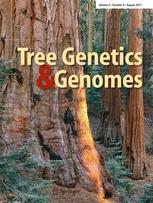Ver ítem
- xmlui.general.dspace_homeCentros Regionales y EEAsCentro Regional Patagonia NorteEEA BarilocheArtículos científicosxmlui.ArtifactBrowser.ItemViewer.trail
- Inicio
- Centros Regionales y EEAs
- Centro Regional Patagonia Norte
- EEA Bariloche
- Artículos científicos
- Ver ítem
Genetic versus environmental contributions to variation in seedling resprouting in Nothofagus obliqua
Resumen
Resprouting is an almost universal functional trait in temperate angiosperms and confers persistence at an individual level after the loss of above-ground biomass. The importance of genetic versus environmental sources of intraspecific variation in resprouting traits is largely unknown. We conducted two genetic field trials, 400 m apart in altitude, in order to sequentially assess seedling resprouting in four environmentally contrasting Argentinean
[ver mas...]
Resprouting is an almost universal functional trait in temperate angiosperms and confers persistence at an individual level after the loss of above-ground biomass. The importance of genetic versus environmental sources of intraspecific variation in resprouting traits is largely unknown. We conducted two genetic field trials, 400 m apart in altitude, in order to sequentially assess seedling resprouting in four environmentally contrasting Argentinean populations of Nothofagus obliqua Mirb. (Oerst). We also performed one nursery test to determine whether populations differed in early root/shoot biomass partition, a key trade-off affecting resprouting. Initial resprouting vigour and final survival were higher in our warmer test site, located 300 m below the core range of the species. The main contrasts between populations were found for pre-clipping seedling size and resprouting profusion, the latter trait showing a clear trade-off with resprouting vigour. Site × population interactions were due mainly to the behaviour of the highest altitude population, suggesting its divergent adaptive trajectory and higher plasticity for resprouting traits. Within populations, trait heritability was low, in general. Episodic frost, which may limit resprouting vigour and final success, had a lower incidence in the altitudinal and xeric limit populations. Overall, our work revealed genetic variation between populations of N. obliqua in traits that determine the success of seedling resprouting, probably associated with divergent selection. Low trait heritability suggests limited in situ micro-evolutionary capacities for resprouting traits under ongoing climate warming; phenotypic plasticity may play an important role in population persistence at the low positions of the elevation gradients N. obliqua currently inhabits.
[Cerrar]

Autor
Aparicio, Alejandro Gabriel;
Zuki, Sebastián Maximiliano;
Azpilicueta, Maria Marta;
Barbero, Fernando Alvaro;
Pastorino, Mario Juan;
Fuente
Tree Genetics & Genomes 11 : 23. (April 2015)
Fecha
2015-04
Editorial
Springer
ISSN
1614-2942
1614-2950
1614-2950
Formato
pdf
Tipo de documento
artículo
Palabras Claves
Derechos de acceso
Restringido
 Excepto donde se diga explicitamente, este item se publica bajo la siguiente descripción: Creative Commons Attribution-NonCommercial-ShareAlike 2.5 Unported (CC BY-NC-SA 2.5)
Excepto donde se diga explicitamente, este item se publica bajo la siguiente descripción: Creative Commons Attribution-NonCommercial-ShareAlike 2.5 Unported (CC BY-NC-SA 2.5)

